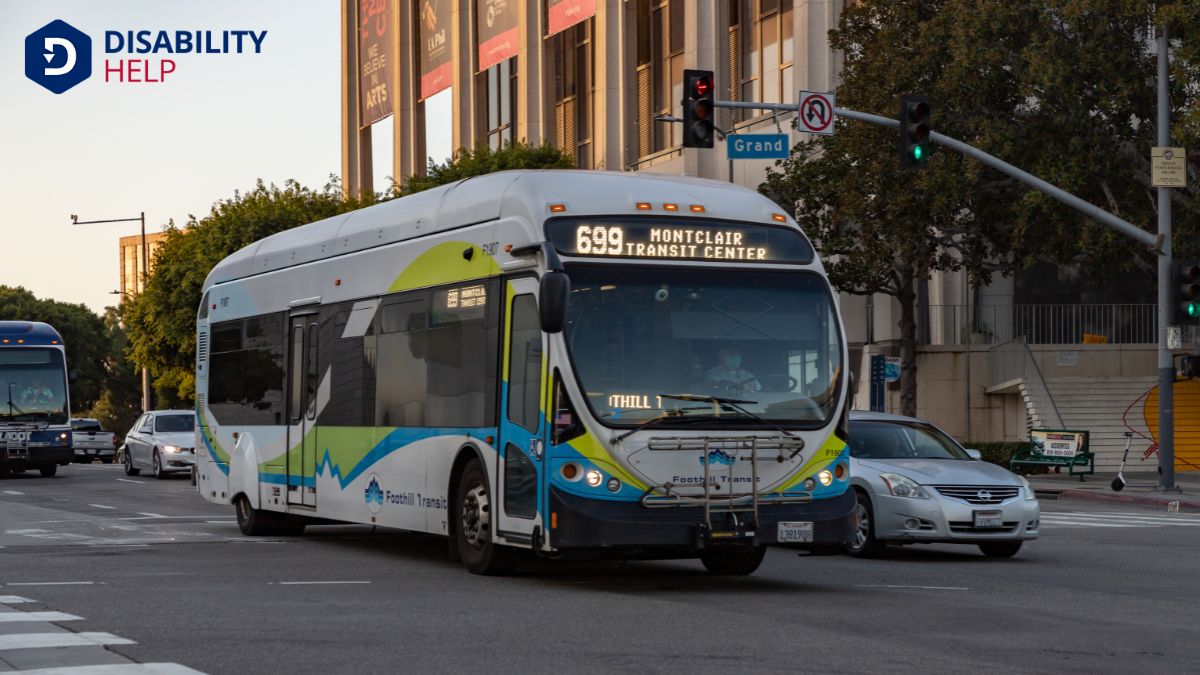When we think about public transportation, it's important to contemplate how it serves everyone, including those with disabilities. An ADA rider is someone whose disability considerably impacts their ability to use standard transit options, and they're entitled to specialized assistance under the Americans with Disabilities Act. But what exactly does being an ADA rider involve, and how does it affect public transit systems? Let's explore this topic further.
Key Takeaways
- An ADA rider is an individual with a disability that limits the use of standard public transportation.
- ADA riders are eligible for specialized paratransit servicesTransportation services designed to accommodate individuals with disabilities who cannot use regular... through local transit authorities.
- The rights of ADA riders include fair, respectful service and reasonable modifications to accommodate their needs.
- Public transportation must include accessible features like ramps, lifts, and priority seating for ADA riders.
- ADA riders can file complaints if they encounter barriers or discrimination in accessing services.
Understanding the ADA and Its Relevance to Public Transportation

The Americans with Disabilities Act (ADA)A U.S. law that prohibits discrimination against individuals with disabilities in all areas of publi... is an essential piece of legislation that guarantees equal accessThe principle that all individuals, including those with disabilities, should have equal opportunity... to public transportation for individuals with disabilities. It guarantees that our transportation systems accommodate everyone, providing necessary adjustments and services.
By understanding the ADA's relevance, we recognize its fundamental role in promoting independence and mobility for those with disabilities.
We need to appreciate how the ADA transforms public transportation. It requires transit agencies to offer services like accessible buses, paratransit options, and proper signage for those with varying needs.
Compliance with the ADA means we all benefit from a more inclusive and equitable system. Let's remember that when public transportation is accessible, it empowers all of us, creating communities where every individual can participate fully and equally.
Defining an ADA Rider: What It Entails
Let's explore what makes an ADA rider essential in public transportation.
We'll examine who qualifies for this rider, the rights and protections it offers, and the service accessibilityThe design of products, devices, services, or environments to be usable by people with disabilities.... requirements that must be met.
Eligibility for ADA Rider
Understanding eligibility for becoming an ADA rider involves recognizing the criteria that qualify individuals for this essential service.
First, we must identify if a person has a disability that notably limits their ability to use standard public transportation. This might include physical, visual, or cognitive impairments.
Next, it's vital to take into account the functional limitations these disabilities impose on accessing transportation systems. Some individuals may need specialized assistance due to mobility issues or the inability to navigate conventional routes independently.
We also need to evaluate whether the individual's disability prevents them from reaching a bus or train stop.
It's important to apply for ADA paratransit services through our local transit authority, which will assess eligibility based on specific guidelines.
Understanding these criteria helps us guarantee accessibility for all.
Rights and Protections
Having established who qualifies as an ADA rider, let's explore the rights and protections that come with this designation.
As ADA riders, we're entitled to a level of service that must be fair, respectful, and free from discrimination. Public transportation agencies have a responsibility to guarantee that our experience is equitable.
We've the right to request reasonable modifications to policies and practices to accommodate our needs. This means that transit operators should work with us to find practical solutions guaranteeing our access to services.
Moreover, we're protected under the ADA against retaliation or intimidation for exercising our rights. If we face barriers or discrimination, we can file complaints to seek redress.
Understanding these rights empowers us to advocate for ourselves effectively.
Service Accessibility Requirements
While we navigate the complexities of public transportation, it's crucial to understand the specific service accessibility requirements that define us as ADA riders.
These requirements guarantee that transportation services accommodate our diverse needs, promoting inclusivity. We must have access to vehicles equipped with features like ramps, lifts, and priority seating to facilitate easier boarding and alighting.
Operators should announce stops clearly, catering to those with visual or auditory challenges. Our service animals are always welcome, and any communication barriers should be addressed with alternative formats such as braille or large print.
It's our right to receive timely, reliable service without discrimination. Understanding these requirements empowers us to advocate for our needs and guarantee that transportation remains accessible to all.
The Legal Framework Behind ADA Riders
The legal framework behind ADA riders is vital for ensuring equal access to public transportation for individuals with disabilities. At the core, the Americans with Disabilities Act (ADA) mandates that public transit systems accommodate passengers with disabilities.
This legislation requires transit agencies to provide equivalent service levels, ensuring that everyone can travel independently and with dignity. We must understand that the ADA is more than just a guideline; it's a binding legal requirement.
It obligates transit providers to implement necessary modifications, like offering accessible vehicles and ensuring barrier-free facilities. By grasping this framework, we can better appreciate its role in promoting inclusivity and compliance.
It's important for us to support these legal measures, ensuring they're effectively executed for the benefit of all.
Key Features of ADA Riders in Public Transit
To guarantee that public transit is accessible to everyone, ADA riders come with several key features that enhance inclusivity.
First, ADA riders benefit from priority seating, which guarantees space for those who need it most. Accessible vehicles are equipped with ramps or lifts, providing easy boarding for individuals with mobility devices.
We also recognize the importance of clear signage and audio announcements, aiding riders with visual or hearing impairments.
Additionally, operators are trained to assist passengers with disabilities, fostering a supportive environment.
Schedules and routes are carefully designed to accommodate the needs of all, including those requiring more frequent stops.
Eligibility Criteria for ADA Riders
As we explore the eligibility criteria for ADA riders, let's first consider the qualifying disabilities that allow individuals to access these services.
We'll also walk through the application process to guarantee those in need can navigate it smoothly.
Qualifying Disabilities Criteria
When considering eligibility for ADA rider status, it's essential to focus on the specific disabilities that qualify an individual for these services. Understanding these criteria helps guarantee that public transportation is accessible to those who truly need it.
Let's break down the basics:
- Physical Disabilities: Individuals with impairments that limit mobility, such as those requiring wheelchairs or other mobility aidsDevices designed to help individuals move around more easily, such as canes, walkers, or wheelchairs..., often qualify for ADA services.
- Sensory Disabilities: Those who are visually or hearing impaired may meet the criteria, especially if these impairments make it challenging to navigate standard public transportation systems safely.
- Cognitive Disabilities: People with cognitive conditions affecting their ability to use regular transit independently may also qualify.
Application Process Overview
Although maneuvering the application process for ADA rider status might seem intimidating, understanding the key steps can simplify it considerably.
First, we need to obtain an application form from our local transit authority, either online or in-person. Next, complete the form with accurate personal information and details about our disability. It's vital to provide medical documentation that verifies our condition and explains how it impacts our ability to use regular public transportation.
After submitting the application, we may be required to attend an in-person interview or assessment. This step helps the transit authority better understand our needs.
Once the process is complete, we'll receive a written determination. If approved, our ADA rider status will grant us access to essential transportation services designed for individuals with disabilities.
How ADA Riders Are Implemented in Transit Systems
Implementing ADA riders in transit systems requires careful planning and coordination to guarantee accessibility for all passengers. We need to confirm that our transportation services are inclusive and meet the needs of everyone.
Here's how we can achieve this:
- Infrastructure Updates: We must evaluate and modify existing facilities to accommodate ADA requirements, such as adding ramps, elevators, and tactile paving for visually impaired individuals.
- Staff Training: It's essential to train our personnel on ADA compliance and sensitivity, ensuring they provide the necessary support to passengers with disabilities.
- Communication Systems: We should incorporate clear and accessible communication methods, like audible announcements and visual displays, to assist passengers in maneuvering transit systems.
Challenges and Limitations of ADA Riders
While ensuring accessibility for all transit users is a crucial goal, we face several challenges and limitations in fully implementing ADA riders.
Limited funding often restricts the ability to upgrade infrastructure and vehicles to meet ADA standards. We also encounter hurdles in training staff adequately to assist riders with diverse needs.
In addition, scheduling and routing logistics can be complex, leading to delays and inefficiencies that impact service reliability. Communication barriers can arise, especially for individuals with sensory impairments, making it difficult to provide timely information.
Moreover, balancing the needs of ADA riders with those of the general public can sometimes create tension, as resources are finite. Addressing these challenges requires ongoing commitment, creativity, and collaboration from all stakeholders.
Success Stories: ADA Riders Making a Difference
Through dedicated efforts and innovative approaches, we've seen remarkable success stories emerge from the implementation of ADA riders in public transportation.
These stories highlight real change and inspire us to keep pushing for accessibility.
Let's take a closer look at three impactful examples:
- Increased Independence: Many riders report newfound freedom, allowing them to travel independently to work, school, and social events without relying on others.
- Improved Accessibility: Transit systems have revamped their services, incorporating accessible vehicles and facilities, benefiting not only ADA riders but all passengers.
- Community Engagement: Public transportation providers have engaged directly with the community, ensuring that services meet the actual needs of ADA riders and fostering an inclusive environment.
These stories remind us that ADA riders are essential to creating a more accessible world.
Future Developments in ADA Rider Policies

Building on the inspiring success stories of ADA riders, we now look forward to future developments in ADA rider policies.
As we envision enhancements, technology will play a pivotal role. Imagine apps that offer real-time updates on accessible routes and features, empowering us to plan trips with confidence.
We'll likely see increased funding for infrastructure improvements, ensuring all public transportation systems are genuinely inclusive. Policymakers might also focus on training transit staff to better assist ADA riders, fostering a more supportive environment.
Importantly, we should advocate for ongoing dialogue between riders and service providers, ensuring policies evolve with our needs. By staying informed and engaged, we can help shape a future where accessibility is standard, not an exception.
Conclusion
In understanding ADA riders, we've explored how these essential services empower individuals with disabilities to navigate public transportation independently. We've also highlighted the legal framework that protects their rights and the eligibility criteria required. While challenges remain, the stories of success demonstrate significant progress. As we look to the future, let's continue advocating for more inclusive policies, ensuring everyone can access public transit with dignity and ease. Together, we can make public transportation truly accessible for all.






